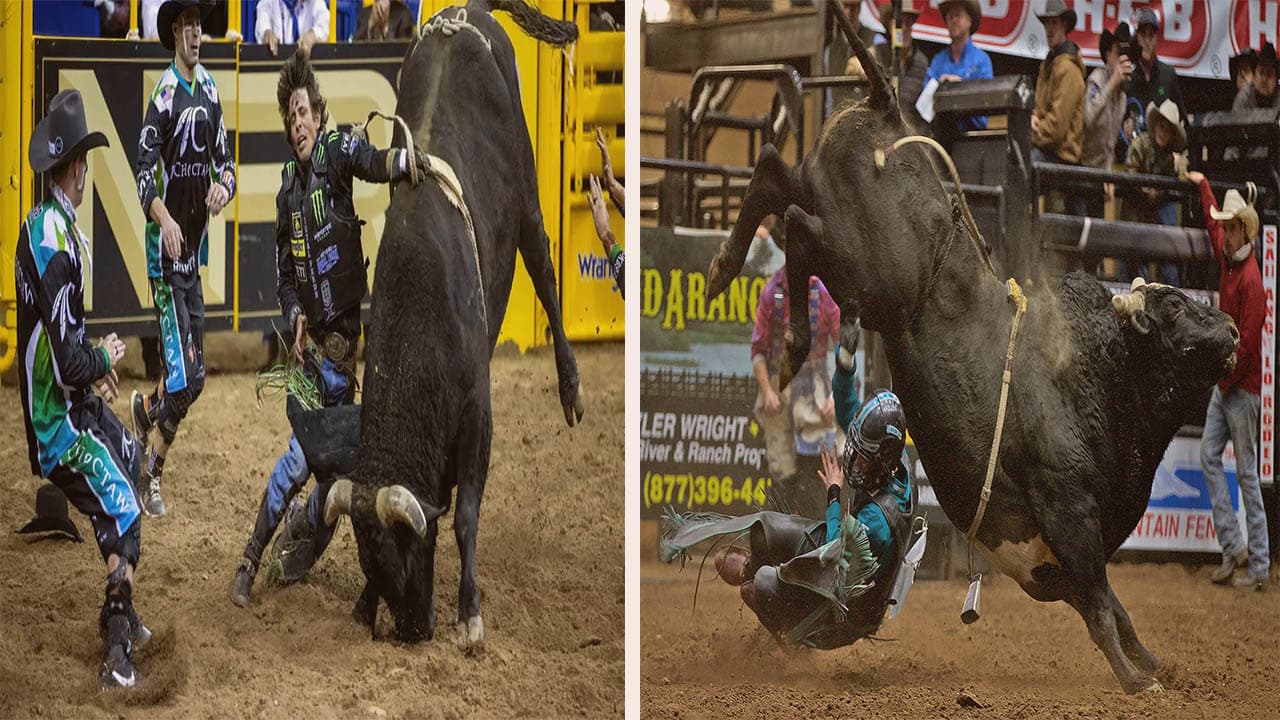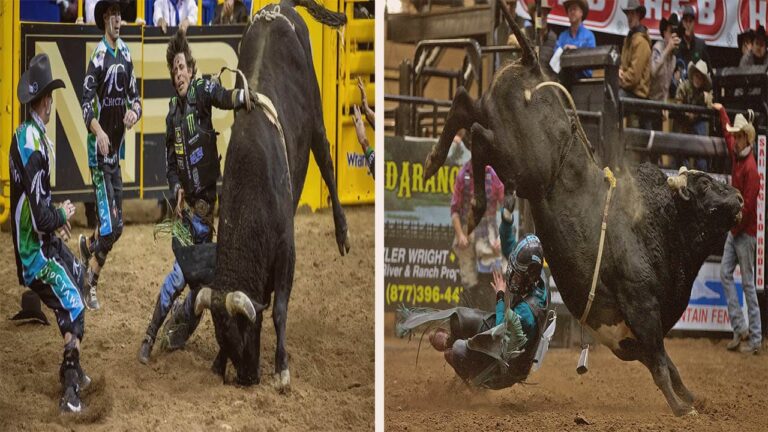Bull riding is an exhilarating and high-risk sport that demands courage, skill, and physical endurance. As riders take on the challenge of taming powerful bucking bulls, they expose themselves to various dangers and risks. This article explores the Top NFR Bull Riding Injury commonly associated with NFR (National Finals Rodeo) bull riding and highlights the importance of safety measures to protect the riders.

Some Common NFR Bull Riding Injuries
The adrenaline-fueled world of bull riding carries inherent risks that can lead to severe injuries. Some of the most common injuries include:
-
Concussions and Head Injuries
Bull riders face the constant threat of head trauma due to impacts from falls or being struck by the bull’s hooves or head. Concussions, skull fractures, and traumatic brain injuries are not uncommon in this extreme sport.
-
Broken Bones and Fractures
The sheer force and violence of a bull’s bucking motion can cause bones to break or fracture. Commonly affected areas include the ribs, arms, legs, and collarbones. Such injuries can be painful and may require surgical intervention.
-
Spinal Injuries
When riders are thrown off a bull, they may land forcefully on their backs, leading to spinal injuries. These injuries can range from herniated discs and spinal fractures to more severe conditions like spinal cord damage, which can result in paralysis.
-
Internal Injuries
The intense and unpredictable movements of the bull can cause internal injuries. Organs such as the liver, spleen, and kidneys may be subject to bruising, lacerations, or even rupture, leading to potentially life-threatening situations.
-
Soft Tissue Injuries
Muscles, tendons, and ligaments can be strained, sprained, or torn during rigorous bull riding events. Soft tissue injuries can result in significant pain, swelling, and limitations in mobility.
Severity and Impact of NFR Bull Riding Injuries
The consequences of NFR bull riding injuries extend beyond immediate physical harm. Riders often experience:
-
Physical Consequences and Long-Term Effects
Severe injuries may require extensive medical treatment, surgeries, and rehabilitation. Chronic pain, limited mobility, and physical disabilities can impact a rider’s quality of life and ability to continue participating in the sport.
-
Emotional and Psychological Impact
Enduring a serious injury can have profound emotional effects on bull riders. Fear, anxiety, depression, and post-traumatic stress disorder (PTSD) are common psychological challenges faced by those who have experienced traumatic incidents.
-
Financial Implications
Medical expenses, loss of income due to inability to participate, and ongoing rehabilitation costs can place a significant financial burden on riders and their families. In some cases, career-ending injuries may result in the need for a new source of income.
Some of the Top NFR Bull Riding Injuries
To understand the gravity of these injuries, let’s explore the top NFR bull riding injuries in more detail:
-
Concussions and Head Injuries
Concussions can cause dizziness, confusion, memory problems, and long-term cognitive impairments. Severe head injuries may require hospitalization and can have lasting effects on a rider’s overall well-being.
-
Broken Bones and Fractures
Fractures commonly occur in the upper extremities, such as arms and collarbones, due to the instinctive reflex of riders to brace themselves during falls. These injuries often require casting, splinting, or surgical interventions for proper healing.
-
Spinal Injuries
Spinal injuries can vary in severity, from fractures that require bracing to more severe cases resulting in partial or complete paralysis. Rehabilitation and adaptive techniques are necessary to aid in the recovery process.
-
Internal Injuries
Injuries to internal organs can be life-threatening and require immediate medical attention. Prompt diagnosis and surgical intervention may be necessary to repair damaged organs and prevent further complications.
-
Soft Tissue Injuries
Muscle strains, ligament sprains, and tendon tears are prevalent due to the intense physical demands of bull riding. Proper rest, physical therapy, and rehabilitation are crucial for recovery and reducing the risk of re-injury.
Prevention and Safety Measures From Injuries
To mitigate the risk of injuries in NFR bull riding, various safety measures should be implemented:
-
Protective Gear and Equipment
Wearing a well-fitted, certified bull riding helmet, mouthguard, padded vests, and protective vests can reduce the severity of head and body injuries.
-
Training and Skill Development
Proper training programs that emphasize strength, agility, balance, and flexibility can enhance a rider’s ability to maintain control and minimize the risk of injury.
-
Medical Support and Emergency Preparedness
Having medical professionals, such as paramedics and sports medicine specialists, readily available during events can ensure a timely and effective treatment in case of injuries.
-
Rule Changes and Regulations
Implementing and enforcing rules and regulations aimed at promoting rider safety, such as restricting the use of certain equipment or addressing dangerous bull behavior, can help reduce the occurrence of injuries.
NFR Bull Riding Injury Rehabilitation and Recovery
After sustaining an NFR bull riding injury, appropriate rehabilitation and recovery strategies are crucial for optimal healing and functional restoration:
-
Treatment Options for Specific Injuries
Each injury requires specialized medical attention, and treatment plans may include surgery, medication, physical therapy, or a combination of approaches tailored to the individual’s needs.
-
Physical Therapy and Rehabilitation Programs
Comprehensive rehabilitation programs are designed to restore strength, flexibility, and functionality. Therapists use techniques like therapeutic exercises, manual therapy, and therapeutic modalities to aid in the recovery process.
-
Psychological Support and Coping Strategies
Mental health support is essential to help riders navigate the emotional challenges that arise from injuries. Therapists and counselors can provide coping strategies, stress management techniques, and emotional support to facilitate psychological healing.
FAQ About NFR Bull Riding Injury
How dangerous is NFR bull riding?
NFR bull riding is one of the most dangerous sports due to the inherent risks involved. Riders face the potential for severe injuries, including concussions, broken bones, spinal injuries, internal injuries, and soft tissue injuries.
What are the most common injuries in NFR bull riding?
The most common injuries in NFR bull riding include concussions and head injuries, broken bones and fractures, spinal injuries, internal injuries, and soft tissue injuries.
Are bull riders required to wear protective gear?
While protective gear is not mandatory in all competitions, it is highly recommended and often worn by bull riders. Protective gear includes certified bull riding helmets, mouthguards, padded vests, and protective vests to minimize the risk and severity of injuries.
How do bull riders recover from injuries?
Recovery from NFR bull riding injuries typically involves a combination of medical treatment, rehabilitation, and rest. Treatment options may include surgeries, medications, and physical therapy. Rehabilitation programs focus on restoring strength, flexibility, and functionality to aid in the rider’s recovery.
Can bull riders return to the sport after a severe injury?
The ability to return to bull riding after a severe injury depends on the nature and extent of the injury, as well as the individual’s recovery progress. Some riders may be able to resume their careers, while others may have to retire due to permanent disabilities or medical recommendations.
How can bull riding injuries be prevented?
Prevention of bull riding injuries involves several strategies, including wearing proper protective gear, implementing effective training programs, providing medical support during events, and enforcing rules and regulations aimed at promoting rider safety. It is important to prioritize safety measures and adhere to best practices.
Are there psychological effects associated with bull riding injuries?
Yes, sustaining a severe injury in bull riding can have significant psychological effects on riders. They may experience fear, anxiety, depression, or post-traumatic stress disorder (PTSD). Mental health support and counseling can help riders navigate these emotional challenges and aid in their recovery.
Are there financial implications for bull riders with injuries?
Yes, bull riding injuries can have financial implications. Riders may face medical expenses, loss of income due to the inability to participate, and ongoing rehabilitation costs. In some cases, career-ending injuries may require riders to seek alternative sources of income.
Are there ongoing efforts to improve rider safety in NFR bull riding?
Yes, there are ongoing efforts to improve rider safety in NFR bull riding. These include promoting safety awareness, implementing stricter safety regulations, improving protective gear technology, providing medical support during events, and educating riders about injury prevention and proper techniques.
How can spectators support rider safety in bull riding events?
Spectators can support rider safety by advocating for comprehensive safety protocols, respecting the rules and regulations, and promoting a culture of safety awareness. Additionally, supporting organizations and initiatives that focus on rider safety and welfare can contribute to creating a safer environment for bull riders.
Conclusion
NFR bull riding injuries pose significant risks to the physical, emotional, and financial well-being of riders. By understanding the top injuries associated with this sport and prioritizing safety measures, we can strive to create a safer environment for riders. Let us advocate for comprehensive safety protocols, injury prevention initiatives, and support systems to protect the athletes who bring us the thrill of bull riding.

